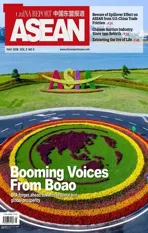RUILI:A BEAUTIFUL PLACE
2018-06-07DuJun,ZhaoLin
Located along the China-Myanmar border, Ruili is China’s largest land port facilitating trade with Myanmar. The city is one of the four largest gemstone trading hubs in China and also the largest rosewood exchange center in southwest China. Connected to Myanmar through mountains and rivers,Ruili has fostered heavy exchanges between Chinese and Myanmar people living on the frontier for many years. People of various ethnicities can be seen everywhere on the street,giving the city a strong exotic charm. Visitors to Ruili enjoy not only natural beauty, but also mouth-watering ethnic cuisines like Dai and Jingpo food as well as Myanmar specialties.
Wanding Frontier Cultural Park
Located in Ruili’s Wanding Economic Development Zone,Wanding Frontier Cultural Park is only 100 meters from the border checkpoint of Wanding Port. The park is home to a total of nine museums including a Memorial of the Chinese Expeditionary Force, World Antique Automobile Collection,World Gemstone Museum,World Postal Museum, Coin Museum, Museum of Chinese,Myanmar and Thai Folk Cultures, Southern Buddhism Museum, Red Memory Museum and Ancient Weapon Museum.Each has countless stories to tell.
Hansha Village
Hansha is both a frontier village and a Ruili scenic spot.Visitors can watch the Peacock Dance (Chinese national intangible cultural heritage) at the inheritor’s house and will leave with a better understanding of the rustic life of the Dai people thanks to farmer painter Tunye’s art and by visiting villagers’home.
Single Tree Forest
Banyans are found everywhere in Ruili, but the Single Tree Forest is the most unique. Rising 36 meters, this banyan tree is about 500 years old. Over the centuries,its above-ground roots have grown into thick, woody trunks spreading across a wide area and intertwining with each other,resembling a grove of trees.Having been nurtured by the sun and the soil, the banyan is now a heaven of lush green and an amazing miracle of nature.
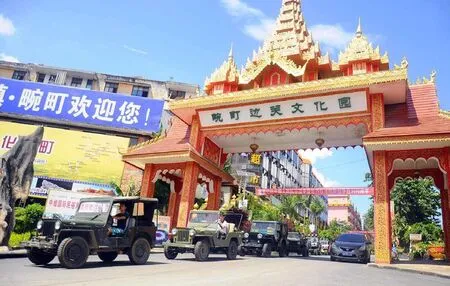
Wanding Frontier Cultural Park.
Treasure Hunting Valley
Treasure Hunting Valley sits by the Nangu River of Ruili.Endowed with abundant mineral resources, the region has been known for gemstone mining since ancient times. Now, the river valley has been developed into a scenic spot wherein tourists can use tools to explore and dig for gemstones.Any gems they find can be identified by gemologists working for the scenic spot administration and be processed into rings, necklaces or bracelets on site.
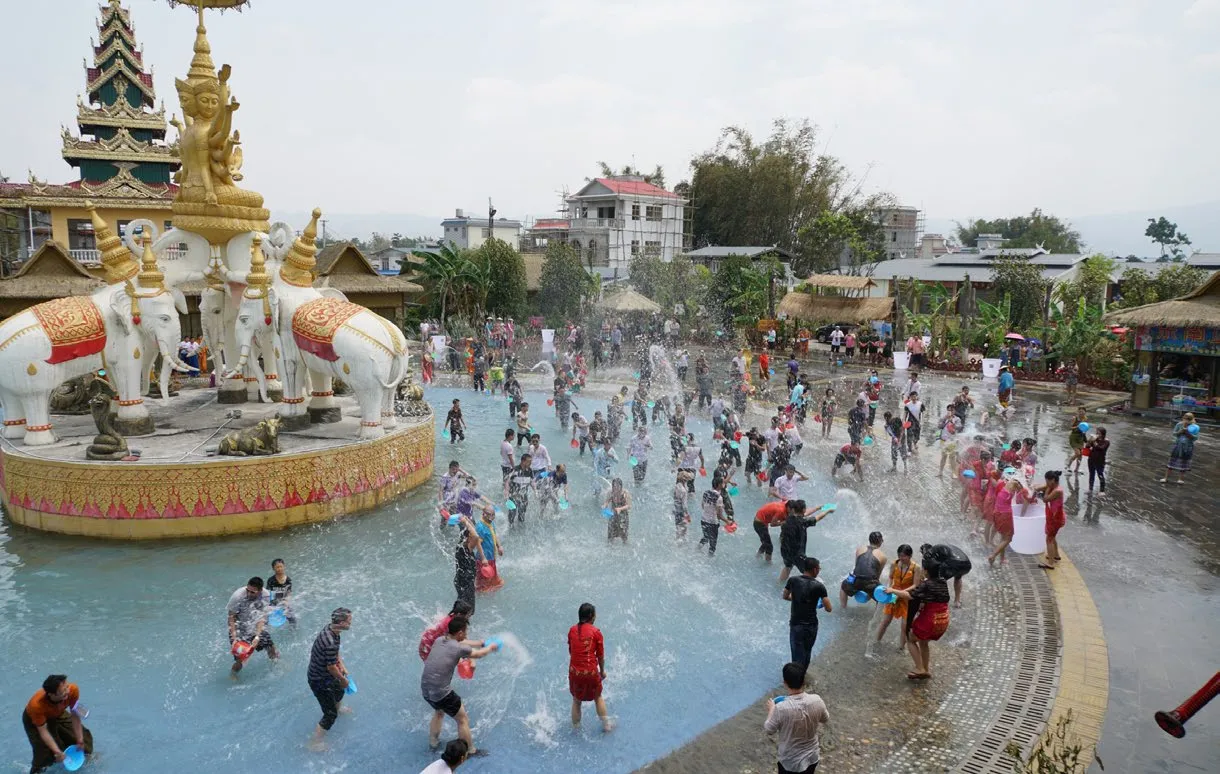
1. Water Splashing Square in Hansha Village.

2. Jiegao Border Trade Zone.
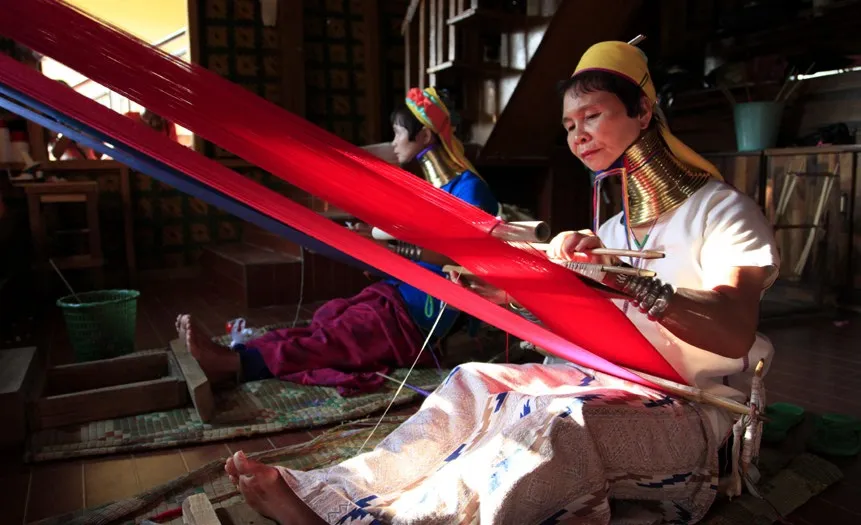
3. The Kayan people of Myanmar, well known for women wearing brass neck coils.
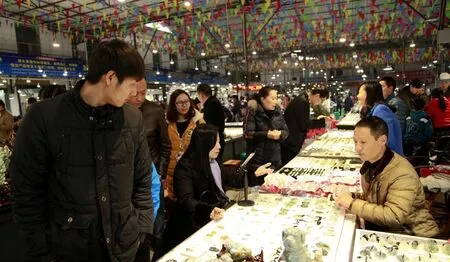
4. A gem market in the Jiegao Border Trade Zone.
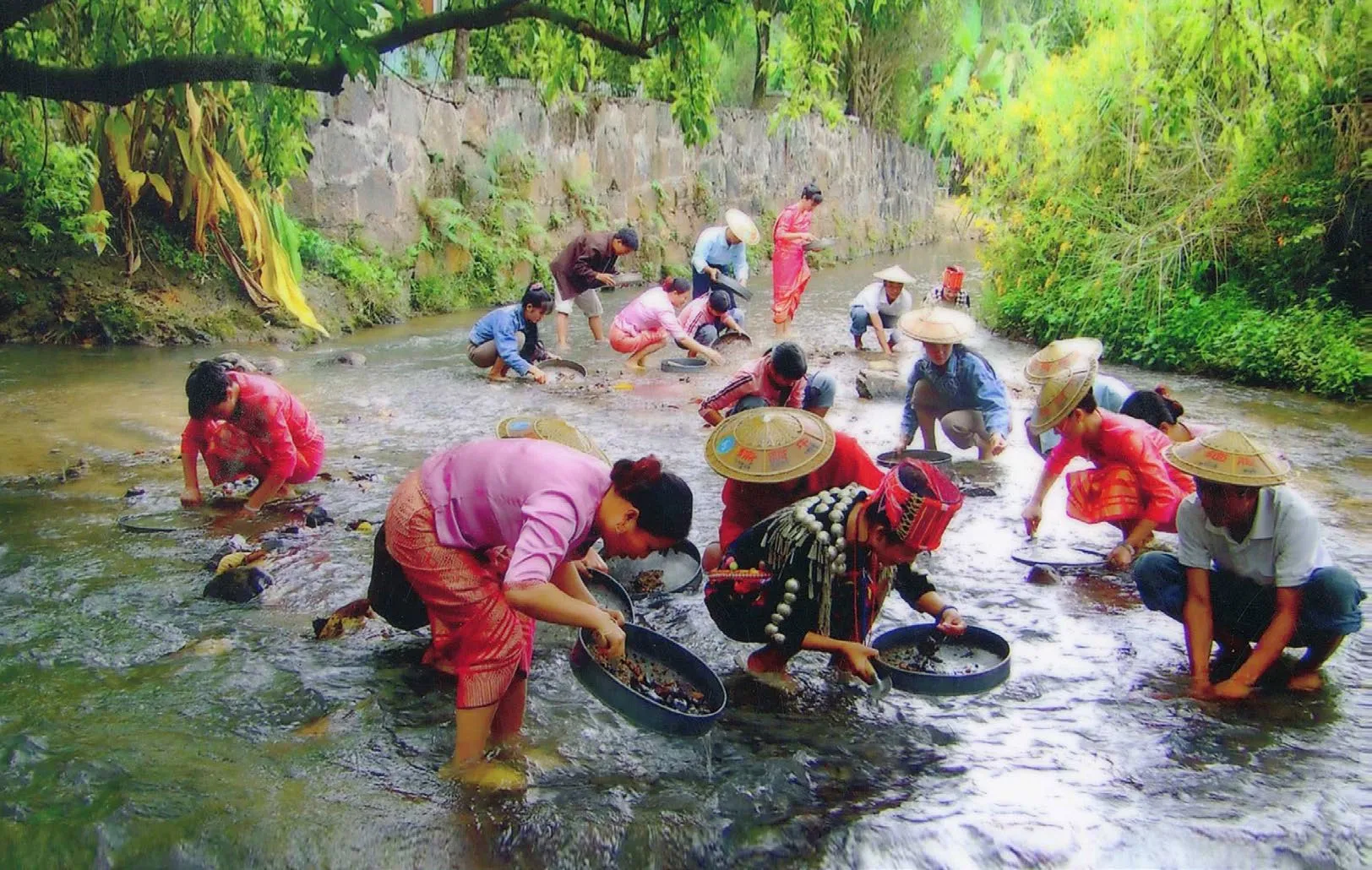
5. Treasure Hunting Valley.
Jiegao Border Trade Zone
Located near Myanmar’s border town of Muse, the Jiegao Border Trade Zone is the only border trade area in China that adopts the “inside territory while outside of customs” preferential policy. Visitors to Jiegao can buy any jewelry imaginable at one of three morning markets:Jiegao Jade Market, Jimao Gem Market and Shunyu Gem Market.In addition to gem markets,visitors can also enjoy shopping in duty-free malls, such as the China-Myanmar Duty-free Shop, Australia Mall and Xinlida Shopping Mall. These retailers offer a wide range of products such as food, clothing, bags,watches, alcohol and tobacco.
One-day Trip to Myanmar
For any visitor to Ruili, it is worth the trip to travel across the China-Myanmar border and spend a day in downtown Muse, which costs only 380 yuan(US$60). Chinese travelers can just take pictures of the city’s exotic scenery and food and post them on social media, boasting about a quick trip abroad.Remember to utilize a qualified travel service provider for the one-day tour in Myanmar such as Ruili Tourism Group.Unmissable Local Cuisine
For many travelers, a taste of local food is the highlight of the journey. Ruili is certainly paradise for foodies, wherein a large variety of local specialties remain on offer day and night—without any repeat.
Ruili’s breakfast features Dai and Myanmar snacks. Dai-style breakfast mainly consists of ersi (a type of rice cake) in beef broth, beef balls and pea congee,and they are usually served with heavy seasoning. Recommended restaurants include Alian Breakfast near the Ruili No. 1 Middle School, Alan Breakfast on Ruijiang Road and Laochengzi Breakfast Stall.
Myanmar-style breakfast features steamed stuffed buns,Myanmar milk tea, curry rice noodles and fried pastries.Recommended restaurants include Bangsai Steamed Bun and Lashio Blue Sky Snacks on Xinguang Road. Te’ao Restaurant is the most highly recommended and offers authentic Myanmar dishes. Most of its customers hail from Myanmar, and its menu includes both Chinese and the Myanmar names.
Speaking of regular meals,visitors can choose from many different styles of dishes such as Dai cuisine, Jingpo cuisine,Achang cuisine, Myanmar cuisine and Thai cuisine. Dai dishes usually taste sour and spicy, represented by sapie (a type of meat salad), sour beef,roasted pork, stewed beef with pickled papaya, lemon fish,grilled fish with lemongrass,fried chicken with lemongrass,stewed chicken with prickly bamboo shoots, stewed fish with prickly bamboo shoots and stewed chicken with pickled papaya. Restaurants serving Dai cuisine are concentrated in areas like Guangla Village, Diannong Village and Laochengzi.
Jingpo cuisine is basically hot and spicy. Instead of being fried, ingredients are often wrapped and roasted in green leaves or pounded with mortar and pestle. Typical Jingpo dishes include spicy chicken salad, pounded beef, fish roasted with leaves, tofu roasted with leaves, enoki mushroom roasted with leaves, vegetable soup and chicken congee. To taste Jingpo cuisine, travelers can visit the Square for Munao Dancing Festival, where some of the best Jingpo restaurants are located. They can also try Jingpostyle pilaf at the Akao Restaurant on Xinguang Road or Yingli Restaurant on Jiegang Road, as well as the bamboo tube rice at Jinghe Restaurant in Jiele Village.Other recommendations include the Jingpo Specialty Restaurant on Munao Road and Yingli Park for Ethnic Culture.
Guoshou Rice Noodles is the most typical food of the Achang ethnic group. Complemented by ingredients like roasted meat,peanuts and chili, this type of rice noodles match perfectly with a special dipping sauce and should be eaten by hand.Thai and Myanmar cuisines are primarily spicy and sour and often made with curry. Typical dishes include curry chicken,lemon fish, tom yum and hot and sour shrimp.
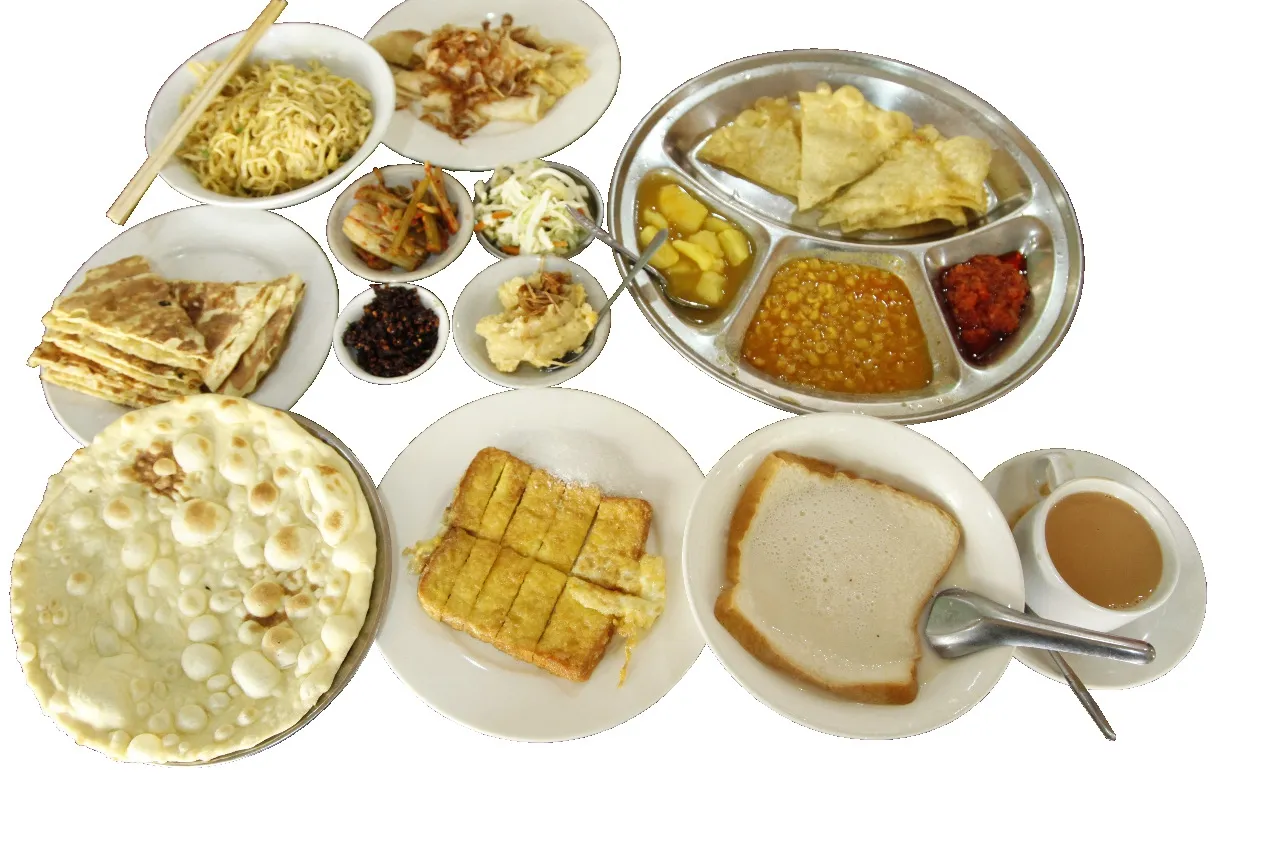
6. Myanmar-style breakfast.
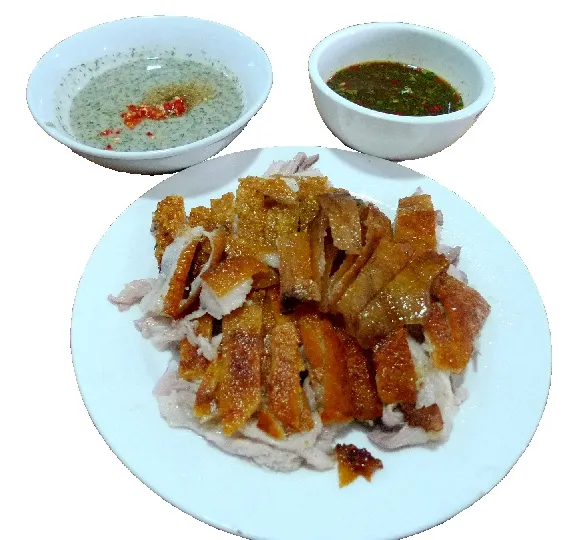
7. Dai-style roasted pork with special dipping sauce.
Top Three Souvenirs
Looking for gifts to bring back for family and friends? The following are the top three local specialties of Ruili:
No.1 — Jadeite. Because Ruili is one of the four largest gemstone trading hubs in China, jewelry is easily its most popular souvenir.From jadeite adornments worth up to tens of millions yuan to jadeite phone charms priced at dozens of yuan, visitors can buy any jadeite products as well as other gems in Jiegao Jade Market, Jimao Gem Market,Shunyu Gem Market, Jewelry Street, Huafeng Market and Delong Gem Market. Thefirst three open in the morning while the last is a night fair.
No. 2 — Rosewood. Ruili is the largest rosewood exchange center in southwest China, so a plethora of products composed of rosewood can be found there,ranging from furniture to small handicrafts like bangles. Ruili International Exhibition Center for Rosewood Furniture is highly recommended.
No. 3 — Myanmar and Thai food. Local snacks are often the most popular souvenirs from any locale globally. In Ruili, visitors should head to Dacai Street to find a variety of quality food featuring Myanmar and Thai flavors.
Visitors to Ruili enjoy not only natural beauty, but also mouth-watering ethnic cuisines like Dai and Jingpo food as well as Myanmar specialties.
Sightseeing around Ruili
If visitors still have time for sightseeing, they will have fun touring a number of popular tourist attractions in surrounding cities and counties.In Mangshi City, tourists can visit the Mengba Naxi Rare Garden (a national AAAA-level tourist attraction of China),Menghuan Grand Golden Pagoda and the Sanxian Cavern. In Longchuan County, visitors can enjoy Long’an Hot Spring,Jingpo Ethnic Park, Rabbit Cave and Husa (a township also known as Buddha’s Garden).In Yingjiang, visitors are consistently amazed by the natural beauty of Xiang’e Lake,Shimi Wadi Village, Xiamengpi Lisu Village, Longmen Village and Zaotang Village. In Lianghe County, travelers can visit Nandian Xuanfu Chieftain Office(also known as the museum of China’s chieftain system) and Longwo Hot Spring.
